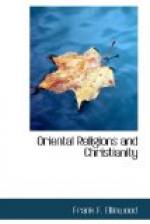long before the sun and moon were visible, and the
day and night were clearly defined. Creation proceeded
in a certain order from vegetable to animal life, and
from lower animals to higher, and last of all man
appeared. In heathen systems we find fragments
of this traditional account, and, as a rule, they are
more or less clear in proportion to their nearness
to, or departure from, the great cradle of the human
race.[167] Thus Professor Rawlinson quotes from an
Assyrian account of the creation, as found upon the
clay tablets discovered in the palace of Assur-bani-pal,
a description of formlessness, emptiness, and darkness
on the deep—of a separation between the
earth and sky—and of the light as preceding
the appearance of the sun. That account also
places the creation of animals before that of man,
whom it represents as being formed of the dust of the
earth, and as receiving a divine effluence from the
Creator.[168] According to an Etruscan saga quoted
by Suidas, God created the world in six periods of
1,000 years each. In the first, the heavens and
the earth; in the second, the firmament; in the third,
the seas; in the fourth, the sun, moon, and stars;
in the fifth, the beasts of the land, the air, and
the sea; in the sixth, man. According to a passage
in the Persian Avesta, the supreme Ormazd created
the visible world by his word in six periods or thousands
of years: in the first, the heavens with the stars;
in the second, the water and the clouds; in the third,
the earth and the mountains; in the fourth, the trees
and the plants; in the fifth, the beasts which sprang
from the primeval beast; in the sixth, man.[169]
As we get farther away from the supposed early home
of the race, the traditions become more fragmentary
and indistinct. The Rig Veda, Mandala, x., 129,
tells us that:
“In the beginning there was neither
naught nor aught; There was neither day nor night
nor light nor darkness; Only the EXISTENT ONE breathed
calmly. Next came darkness, gloom on gloom.
Next all was water—chaos indiscrete."[170]
Strikingly similar is the language quoted in a former
lecture from the prayer of a Chinese emperor of the
Ming Dynasty. It runs thus: “Of old,
in the beginning, there was the great chaos without
form and dark. The five elements had not begun
to revolve, nor the sun and moon to shine. In
the midst thereof there presented itself neither form
nor sound. Thou, O Spiritual Sovereign, didst
divide the grosser parts from the purer. Thou
madest heaven: Thou madest earth: Thou madest
man.”
There is a possibility that these conceptions may
have come from Christian sources instead of primitive
Chinese traditions, possibly from early Nestorian
missionaries, though this is scarcely probable, as
Chinese emperors have been slow to introduce foreign
conceptions into their august temple service to Shangte;
its chief glory lies in its antiquity and its purely
national character. Buddhism had already been
in China more than a thousand years, and these prayers
are far enough from its teachings. May we not
believe that the ideas here expressed had always existed
in the minds of the more devout rulers of the empire?
In similar language, the Edda of the Icelandic Northmen
describes the primeval chaos.




